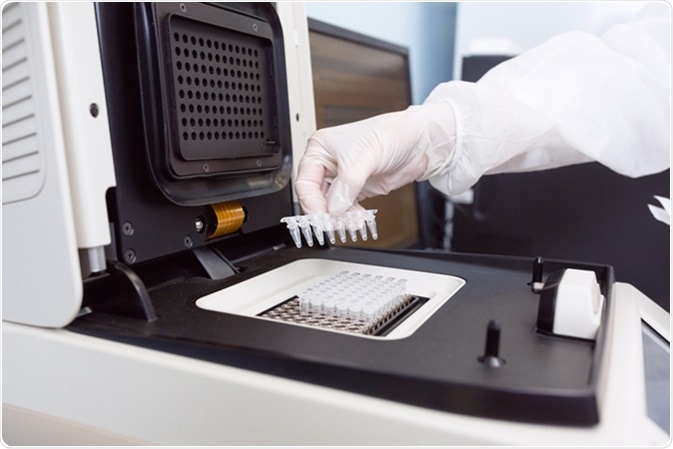Forensic studies usually work with small or trace amounts of samples. DNA from such samples can be limiting, making their analysis difficult. Whole-genome amplification can provide a solution to this problem by providing greater yields from small samples.

Female genetics worker placing the strips with DNA into the PCR thermal cycler or amplifier for PCR diagnostics. Image Credit: UvGroup/Shutterstock.com
Whole Genome Sequencing (WGA)
This method was developed to increase the signals in cases where the DNA sample is limited. There are two main techniques to amplify the whole genome: PCR-based methods and multiple displacement amplification.
What is Genomic Sequencing?
Whole Genome Sequencing Methods in Forensics
Primer extension pre-amplification PCR (PEP-PCR)
PCR-based methods to amplify DNA include degenerate oligonucleotide PCR (DOP-PCR) and primer extension preamplification (PEP) PCR. PEP uses random primers, while DOP-PCR uses semi-degenerate oligonucleotides. In the PEP PCR method, Taq polymerase generates DNA sequences up to 400 kb and is associated with errors in the sequences.
dcDOP-PCR (Degenerate oligonucleotide-primed polymerase chain reaction)
Several specific changes were made in this method, including incorporating a 10N degenerate primer, a higher quality Taq polymerase, and increased non-specific cycles of PCR. The post-PCR amplification step is also increased.
Improved PEP-PCR (I-PEP)
In this method, modifications were made to PEP-PCR based on the forensic needs. Also, in PEP-PCR, the increased number of PCR cycles leads to reduced efficiency of Taq polymerase and increased number of stochastic variations. The primer concentration is also doubled to increase its efficiency in this case.
Nested PCR
Nested PCR is performed to amplify charred samples and minute quantities of blood. However, technical difficulties have been observed while using this method.
Multiple displacement amplification (MDA)
In this method, random hexamers bind to denatured DNA. This is followed by synthesis of DNA using Phi 29 polymerase. This polymerase does not easily dissociate and generates DNA strands up to 100 kb. This polymerase can also resolve secondary structures, including hairpin loops.
This method is widely used in forensic sciences to amplify small DNA samples as it gives good results even when the samples are damaged or have stochastic variations. MDA also provides good results in case of mixed DNA samples.
Next-generation sequencing for forensic DNA analysis
Sequence Bias in Whole Genome Amplification
Although PCR is used to amplify the whole genome, it was found that this method does not cover the whole genome and also has amplification bias where certain sequences are over-represented as primers preferentially bind to specific regions. Phi polymerase can bind without sequence bias and provide uniform amplification across the genome.
Amplifying Fragmental or Damaged DNA During Forensic Analysis
During forensic analysis, the DNA samples are often found to be fragmented or damaged. Depending on the environmental conditions, such as UV radiation, pH, and sample preparation, the degree of damage may vary. The most common reason for DNA damage is chemical or enzyme-induced fragmentation. To address this, techniques such as REPLI-g damaged DNA technology are available which can uniformly amplify fragmented or damaged DNA samples of the whole genome. It involves two steps: in the first step, the damaged DNA is prepared for amplification followed by the second step which involves amplification.
Whole Genome Amplification of Mitochondrial DNA
Although there are only two copies of nuclear DNA, there are thousands of copies of mtDNA in a cell. In several forensic cases, the DNA samples are old, damaged, limited, and degraded. Most of the nuclear DNA amplification methods require DNA to be in a good condition and in sufficient quantities.
In cases where these conditions are not met, whole-genome sequencing of mitochondrial DNA is a possible option. This method can be particularly important in case of identifying missing person or disaster victims.
Conclusions
Whole-genome amplification can provide critical information for forensic science. Specific type of WGA method can be used based on the state of the DNA in the sample. Single-source DNA can be amplified using I-PEP, while MDA can be used for mixed DNA samples.
Further Reading